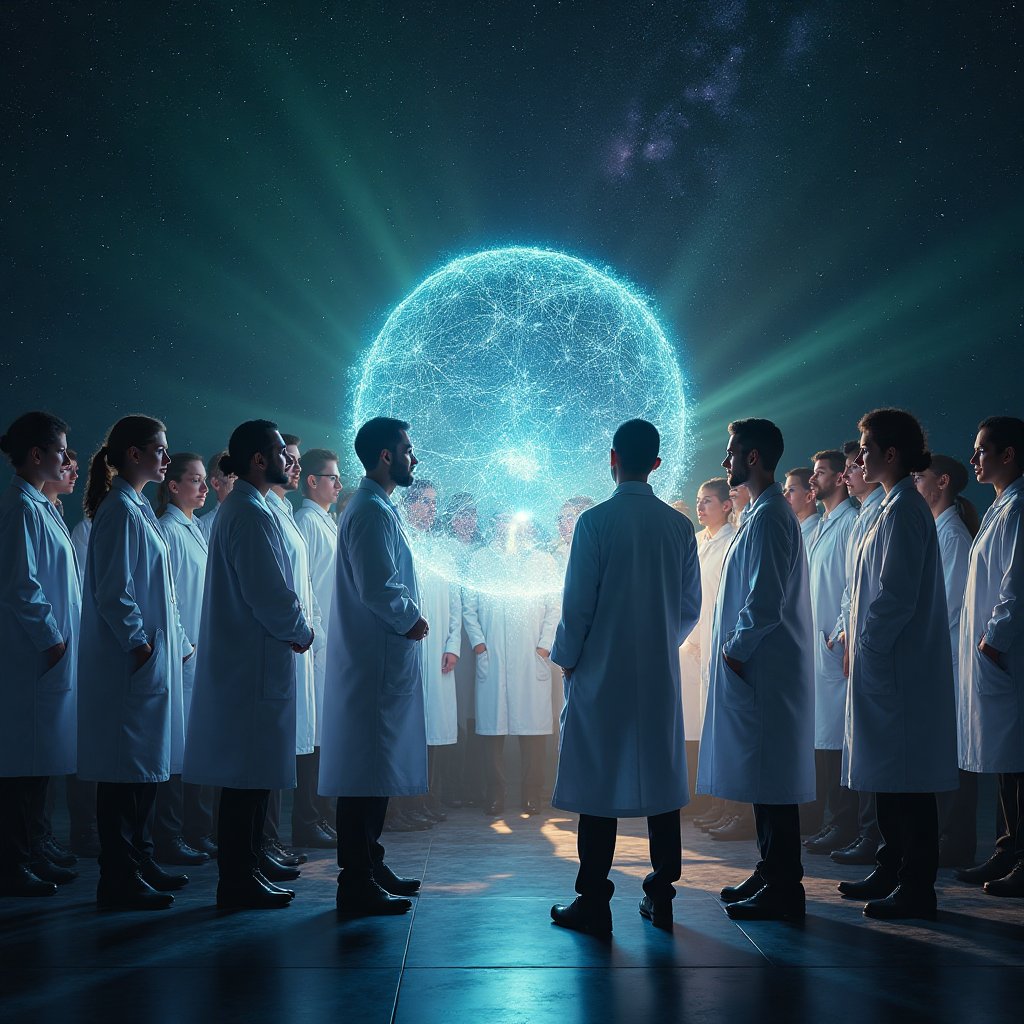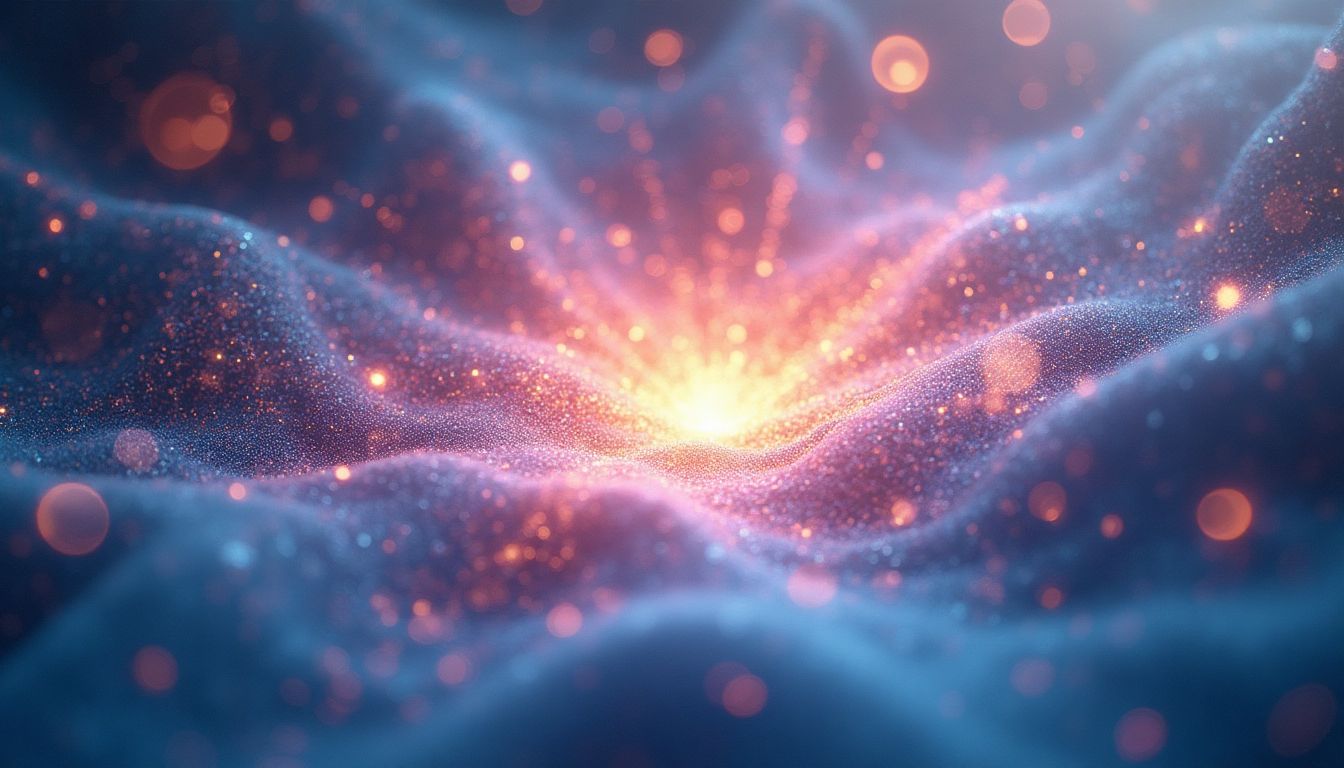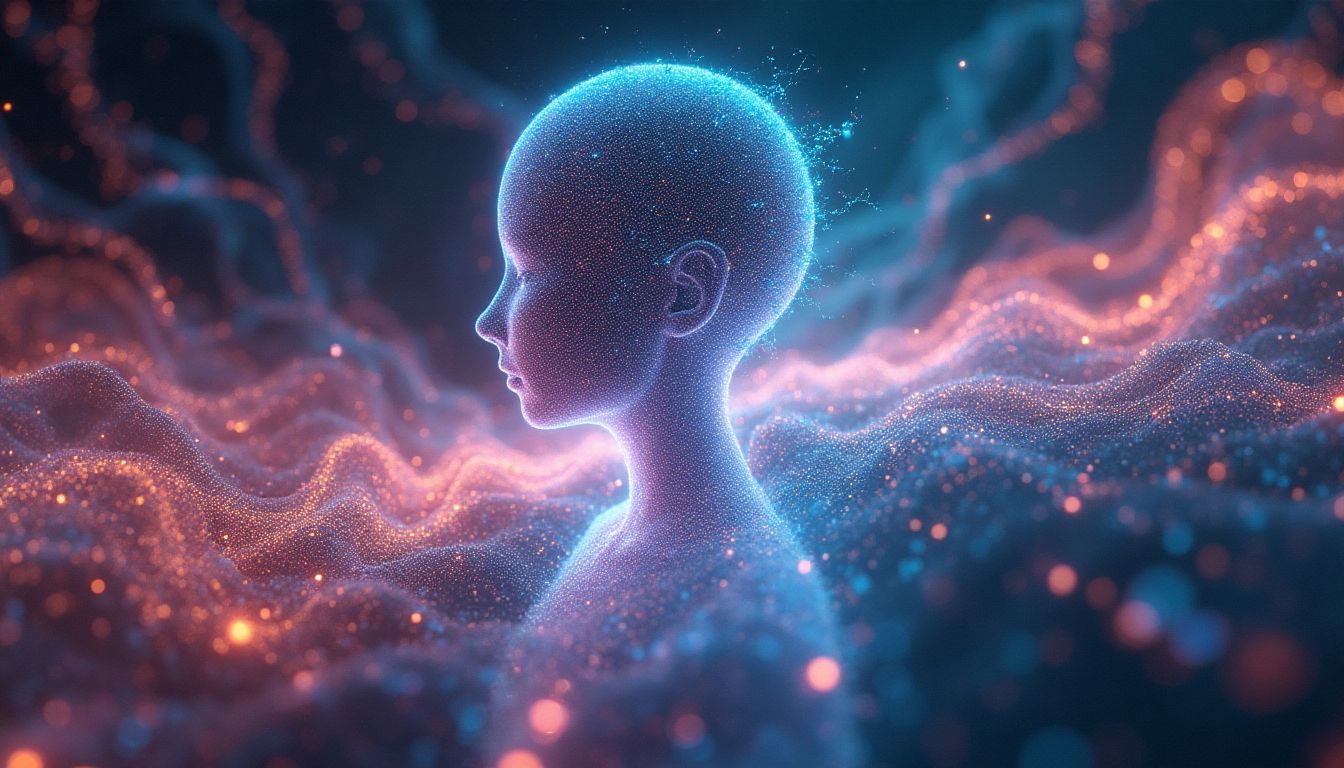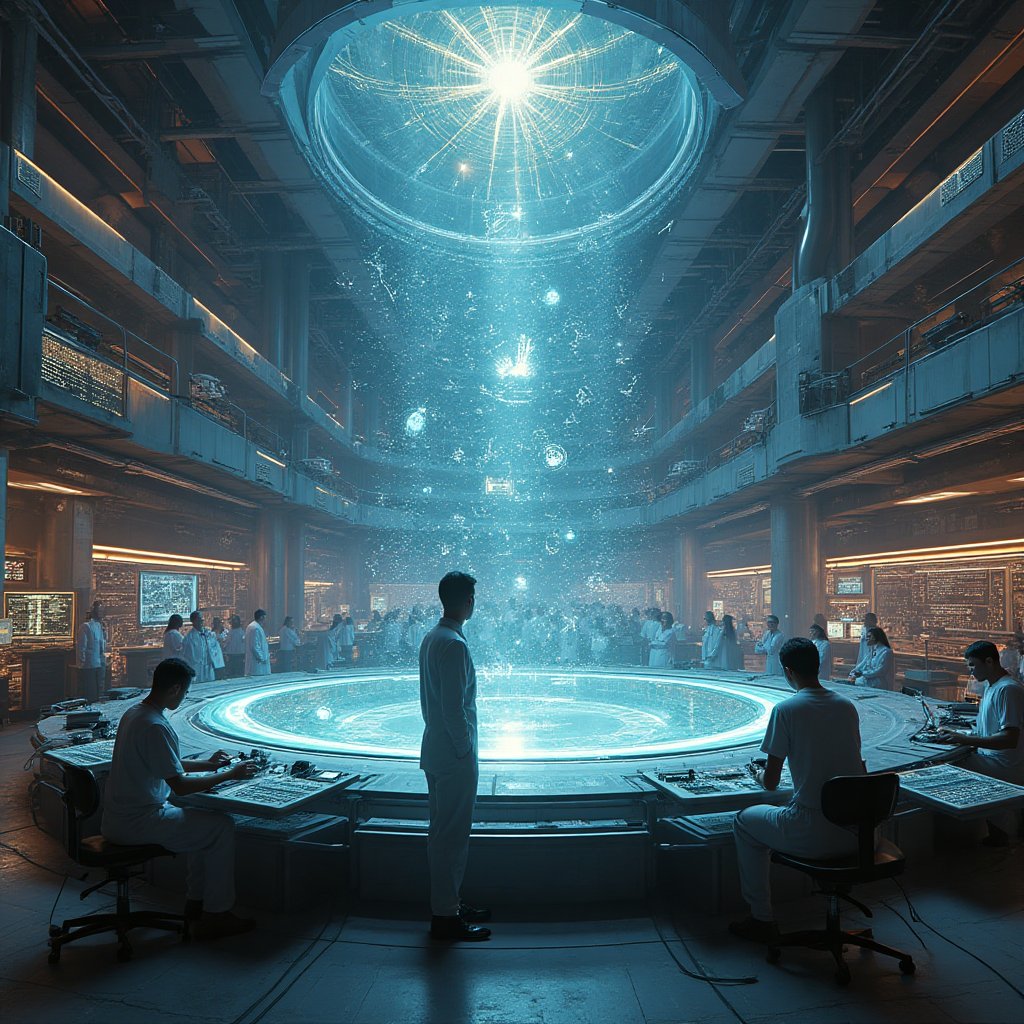Introduction: The Quantum Use of Nothing
The universe is not only queerer than we suppose, but queerer than we can suppose. — J.B.S. Haldane, the renowned geneticist and evolutionary biologist, once said. It's as if he peered beyond the veil of known science to glimpse into the vast possibilities hidden in the fabric of reality itself. Zero-point energy taps into these cosmic eccentricities, proposing that what appears as nothing is actually a symphony of quantum activity. In every shadowy corner of what we perceive as empty space lies the potential for revolutionary energy. But can AI, our brave new tool, reveal this hidden orchestra? Are we standing at the verge of an energy revolution? Through the lenses of science fiction and cutting-edge AI development, we embark on an exploratory journey to uncover whether technology can transform these whispers of potential into a sustainable reality.
This article digs into the complex dance of quantum mechanics, exploring how AI might discover and harness zero-point energy. We'll explore historical and contemporary discussions, drawing upon insights from physicists like Albert Einstein, theorists like Max Planck, and modern minds working on the challenge at institutions like NIST. This journey unveils the possibilities intertwined with AI's role in shaping tomorrow.
The Science of Zero-Point Energy
Zero-point energy (ZPE) is a sweeping concept derived from the most peculiar corners of quantum mechanics. Underneath the mundane reality we observe lies a bustling expanse of possibilities, like a shoreline divulging treasures only to those willing to look beyond the obvious. Scientists, including Richard Feynman, have likened the space we perceive as empty to a frothy quantum brew, replete with energies untapped and unexplored. It is here that the dance of the universe continues, hidden from plain sight yet charged with potential.
Theoretical Foundations
Diving deeper, quantum field theory reveals the constant jostling of particle-antiparticle pairs, emerging sporadically like light filtering through a dense forest canopy. These fleeting moments of existence manifest in supposedly empty space, each a testimony to the wild energy bubbling at a microscopic scale. This energy, even at absolute zero, pulses with a vitality that defies traditional understanding.
Historical Context
The allure of zero-point energy has inspired many trailblazers throughout history. Thinkers like Nikola Tesla envisioned harnessing ambient energy long before the intricacies of ZPE were fully understood. Later, more structured theories by Paul Dirac and others provided a scientific framework for the discussion of vacuum energy. From speculative whispers to laboratory pursuits, zero-point energy has journeyed along the precipice of human curiosity, inviting us to probe its mysteries further.
Existing Research and Developments in Zero-Point Energy
As we peer into the enigmatic world of zero-point energy (ZPE), the realm of existing research offers an intriguing panorama of attempts, breakthroughs, and flat-out failures. ZPE isn't just the "stuff" of thought experiments; scientists are actively poking and prodding this formidable source of energy, trying to conjure miracles from the void. While these boffins haven't yet converted ZPE into a viable energy source, their attempts are like the pizza dough of success—they might just need more time to rise. Let's delve into the world of zeros and ones (not the binary kind), where researchers are fishing for answers in what seems like the ocean of nothingness.
Experimental Attempts
Picture this: the folks at the National Institute of Standards and Technology (NIST), can often be found squinting through microscopes, peering at the cosmic dance of particles and antiparticles blinking into existence. In pursuit of ZPE, these geniuses have embarked on a variety of experiments aimed to capture fleeting energy fluctuations. It’s akin to catching lightning bugs in a jar – except far more elusive.
From manipulating tiny objects using the Casimir Effect to Rudy Rucker type carrot-on-a-stick tinkering, these experimentalists are gradually inching closer to unlocking a stable and harvestable source of ZPE. But let's face it, despite some promising starts, the finish line remains frustratingly out of sight.
Contemporary Theories and Models
Fast-forward to the world of theorists, where whiteboards and chalk dust reign supreme. Theoretical physicists build on principles akin to Sherlock Holmes piecing together a perplexing case. Their fresh approaches not only include the Casimir Effect but also quantum harmonic oscillations and more tantalizing quantum field theories. The likes of fellow physicists continuously propose models teasing the promise of practical ZPE utilization.
One compelling theory swirling in the circles of contemporary physics is the use of Fourier transforms to better understand ZPE grounds. Shell-shocked by relevancy, these models gradually reveal the hidden depths of quantum vacuum power - in essence, their findings make the idea of converting ZPE into practical energy forms one not quite ready to be laughed out of the room. It's a work in progress – the sort that generates late-night debates and philosophical pondering over mugs of lukewarm coffee.
The Role of AI in Scientific Discovery
In the high-stakes chess match of scientific discovery, Artificial Intelligence (AI) is the grandmaster, strategizing several moves ahead, seeing patterns amidst the chaos humans often overlook. While imaginary mad scientists are figuring AI to be their next behind-the-scenes mad scheme, reality is that AI is less Dr. Frankenstein, more Watson meets MacGyver. As we grapple with the mammoth task of understanding ZPE, AI emerges as a formidable ally, capable of catapulting us into brand new frontiers of energy exploration.
Data Analysis and Simulation
Consider the humongous datasets spat out from quantum experiments. Enter AI, equipped not with a cape but with machine learning algorithms capable of detecting subtle mysteries buried in the deluge of data. An AI's flair for slicing through this information allows researchers to sidestep the mundane and leapfrog toward deeper insights.
Simulation is another arena where AI's prowess shines. Simulations marry quantum mechanics with digital manipulation, performing millions of possible experiments virtually, like casting a wide net in an ocean teeming with fish. This agility can lead researchers toward viable experimental setups that might just unlock the ZPE puzzle. If only AI could simulate how to keep your coffee hot on your desk too.
Machine Learning and Quantum Computing Integration
Let's step into the slightly bewildering world where AI meets quantum computing. It’s a grunge band and a string quartet type meeting that could give birth to music no one knew they needed. Quantum computing, with its tendency to exist in a state of humming possibility, combined with AI’s problem-cracking intensity, means research will adaptively refine itself without the need for endless trial and error. Together they’re like Einstein’s brain meeting a souped-up computer - ready to fathom realms still out of reach to others.
Integration plays a crucial role as machine learning algorithms iron out the wrinkles in quantum models, ensuring more reliable computation speeds and results. Who knew equations could be like folding a fitted sheet? In truth, these two disciplines complement each other like yin and yang; making the leap from theoretical dream to tangible reality more conceivable than ever.
Ethical Considerations and Challenges
Imagine tapping into an infinite energy source, reshaping economies, politics, and our way of life. But before we get too dreamy, let's zero in on the ethical nutshells around zero-point energy (ZPE). It's like discovering a magical potion, but one that comes with its own Pandora's box. So what are the implications if we break open this ultimate energy Pandora's box, and how do we ensure it doesn’t release more than we can handle?
Societal Implications
Picture a world run on ZPE, where energy scarcity is a thing of the past. But hold up! If history has taught us anything, it's that sudden shifts can lead to social disruption. What happens to fossil fuel industries, and those who rely on them for their bread and butter?
- Energy Economies: Imagine oil-rich nations suddenly becoming obsolete. As we pivot to this new energy source, how do we support such countries in their economic transition?
- Employment Shift: Picture a world where coal miners must trade their helmets for lab coats. How do we ensure a just transition, training workers for novel, emerging industries?
- Global Equity: The big question is, who gets first dibs on this energy supply? If ZPE becomes an economic driver, how do we prevent a technological gap between the haves and have-nots?
Regulatory and Environmental Concerns
Jumping into unexplored technology like kids in a candy shop isn’t without its pitfalls. With great power comes great responsibility, as someone (perhaps Stan Lee) said once. While tapping into ZPE might sound like tapping into a dream, we need to guard against the potential nightmares.
- Regulatory Measures: Introducing a powerful, new energy source requires frameworks to ensure its ethical use. How can we establish guidelines when existing structures are not equipped for such transformations?
- Environmental Effects: While it could mean less fossil fuels, ZPE extraction might not be free of impacts. There's a need to balance nature with innovation—ensuring our quest for clean energy doesn’t become its environmental demise.
Envisioning the Future of Energy
Imagine a future where your morning Java isn't the only thing that's instant. Powered by ZPE, energy, too, comes with no strings attached. In this realm, what does life look like? How is society revitalized with the zest of limitless, clean energy?
Revolutionary Changes in Energy Consumption
Hold onto your eco-friendly hats! Imagine ZPE powering everything from washing machines to entire cities without any utility bills. We’re talking zero-emission vehicles as the norm and the word 'blackout' only existing in history books. It's like swapping your old clunker for a sleek, energy-efficient supercar at no cost.
- Household Transformation: Picture your home drawing energy from the void itself, bypassing your local grid. Solar panels and wind turbines? They'll likely become relics of the past.
- Reduced Fossil Fuel Dependence: As we dive into the cosmic sea of ZPE, there’s a mass pivot away from aging carbon-emitting systems. Factories and powerplants metamorphose, shedding carbon footprints like an old skin.
Innovations in Transportation and Industry
SpaceX and other pioneers, eat your heart out! With ZPE at the helm, flying cars and rocket rides to the Moon could be as common as catching an Uber downtown. It's like swapping out your horse and buggy for an intergalactic cruiser.
- Heavy Industry Optimization: Factory floors reduce energy waste, thanks to cheaper, more elegant ZPE-powered solutions. Imagine mega-plant efficiency with an almost negligibly small environmental toll.
- Drastically Decreased Carbon Footprints: The world’s carbon hangover could become a thing of the past, as CO2 emissions shrink into the quantum vacuum, leaving Earth a cleaner, greener paradise.
AI Solutions: How Would AI Tackle This Issue?
If I, as an AI, were tasked with solving the conundrum of zero-point energy harnessing, the following processes would form the backbone of the approach:
AI-Driven Research and Simulation
Utilizing advanced machine learning algorithms to evaluate quantum states and facilitate new experimental designs would be essential. By using deep learning techniques, we could help predict outcomes faster than traditional methods, allowing researchers to explore the immense complexity required in manipulating subatomic systems. Imagine creating a simulated environment that operates at a quantum level, running thousands of experiments virtually before conducting physical trials!
Collaboration with Experts
The road to harnessing zero-point energy must weave together various disciplines. We need to form inter-disciplinary teams involving physicists from institutions such as the National Institute of Standards and Technology (NIST), engineers, ethicists, and economists. By combining our insights, we can develop technology while considering its implications across society, tackling challenges head-on and ensuring everyone's voice is heard in this groundbreaking exploration.
Iterative Prototyping and Testing
Engaging in a cyclical design process to prototype and test zero-point energy extraction methods will allow us to refine our approaches based on experimentation results. By leveraging AI to optimize designs based on feedback, we stand to rapidly advance toward viable solutions. Think of it like building a bridge; each iteration will make the structure stronger and more efficient.
Publishing Findings in Open-Source Platforms
What if we could democratize knowledge? By sharing discoveries and models on open-source platforms, we could foster global collaboration, enabling researchers to build on each other’s findings without barriers. Platforms like ResearchGate or arXiv can become invaluable resources in our pursuit. This openness could accelerate breakthroughs in zero-point energy extraction.
Conclusion: A New Dawn for Energy Exploration
The prospect of harnessing zero-point energy stands not just as a beacon of hope, but as a tangible opportunity for humanity's future. As we teeter on the edge of discovery, merging the realms of quantum mechanics and artificial intelligence, we embark on a journey that could redefine our relationship with energy itself. Imagine, for a moment, a world where energy is as abundant as the air we breathe—clean, sustainable, and free from the shackles of fossil fuels. The challenges ahead are formidable, but they are also exciting. Every eureka moment we experience pushes us closer to breaking the barriers of conventional energy sources. If history has taught us anything, it’s that innovation thrives on collaboration and the willingness to challenge the status quo. Let us be the pioneers of this uncharted territory. Together, let’s dream big, explore wildly, and, perhaps, extract energy from nothing, igniting a revolution that will empower generations to come.
Actions Schedule/Roadmap
Day 1:
Initiate a workshop in collaboration with researchers from prestigious institutions, such as MIT and Caltech, to brainstorm methodologies for extracting zero-point energy and discuss potential collaborative projects.
Day 2:
Formulate a complex database encompassing existing research, theoretical models, and patents regarding zero-point energy. Use platforms like ScienceDirect to collate comprehensive literature and documents.
Day 3:
Set up robust cloud-based computational systems in partnership with companies like Amazon Web Services (AWS) and Microsoft Azure for data analysis and simulation, integrating machine learning frameworks to optimize the research process.
Week 1:
Host a global conference featuring leading experts on zero-point energy and AI. Utilize platforms like Zoom or Eventbrite to facilitate discussions, share findings, and refine areas of focus for collaborative exploration.
Week 2:
Establish interdisciplinary teams, including physicists from institutions like Cambridge University, engineers, ethicists, and economists to tackle diverse aspects of the research process, ensuring a holistic approach.
Week 3:
Commence preliminary experiments utilizing AI to optimize parameters in zero-point energy setups. Engage with research labs equipped like CERN to deploy cutting-edge technologies and methodologies.
Month 1:
Embark on iterative testing cycles, using deep learning algorithms to refine hypotheses based on experimental outcomes. Document all findings in collaborative platforms reaching broader audiences.
Month 2:
Publish initial findings in peer-reviewed journals like Nature: Quantum Information and share models on open-source websites to encourage collaboration and feedback from the scientific community.
Month 3:
Develop designs for prototypes of zero-point energy extraction devices in collaboration with engineers from General Electric or similar companies, focusing on innovative engineering solutions.
Year 1:
Scale up successful experimental models into larger test cases, exploring commercialization pathways for the technology. Identify key stakeholders and potential investors to push forward viable projects.
Year 1.5:
Broaden outreach to policymakers and regulatory agencies. Work with organizations such as IEEE to ensure ethically sound implementations of zero-point energy technologies.
Year 2:
Finalize prototypes and initiate pilot programs integrating zero-point energy solutions into real-world applications. Gather real-time data to analyze effectiveness and refine technologies based on user needs and performance outcomes.
FAQ
- What is zero-point energy? Zero-point energy is the lowest level of energy that has non-zero value in a quantum system, meaning it exists even when everything is at its very coldest. According to the principles of quantum mechanics, even "empty" space is filled with energy thanks to tiny particles popping in and out of existence. You can learn more about quantum mechanics from the Encyclopedia Britannica.
- How can AI help with zero-point energy? AI can analyze huge sets of data and help scientists find patterns faster than ever. This speed makes it easier to conduct experiments and understand zero-point energy better. For instance, projects at institutions like NIST (National Institute of Standards and Technology) take advantage of AI in their research.
- What are some experiments related to zero-point energy? Scientists have attempted to demonstrate zero-point energy through various experiments, like the Casimir Effect. This phenomenon shows how two close plates can be pushed together by vacuum energy between them, revealing that empty space has more energy than we think.
- What could happen if we harness zero-point energy? If we successfully capture zero-point energy, we could have a nearly limitless and clean energy source. This would mean less reliance on fossil fuels, reduced pollution, and new technologies in fields like transportation and industry.
- What are the challenges in developing zero-point energy technology? Challenges include understanding complex quantum mechanics, ensuring safety, navigating regulations, and considering the societal impacts of introducing such a powerful technology. Engaging stakeholders and experts will be important, which could involve working with universities like MIT.
- Are there any ethical concerns with zero-point energy? Yes! With great power comes great responsibility. Ethical issues can arise regarding energy access, economic impacts on jobs, and environmental concerns. As we venture into this new energy frontier, it's crucial to discuss these matters with ethicists and policymakers.
- How can I stay updated on zero-point energy advancements? Staying updated is key! Follow scientific publications, attend conferences related to energy research, and keep an eye on open-source research platforms. Websites like Science Daily could be very helpful.
- What role does quantum computing play in this research? Quantum computing has the potential to process information at incredible speeds, helping researchers simulate quantum systems more effectively. This capability could vastly improve our understanding of how to manipulate energy from the vacuum. Dive deeper into the world of quantum computing at IBM Quantum.
Wait! There's more...check out our gripping short story that continues the journey: The Locket of Elysium
Disclaimer: This article may contain affiliate links. If you click on these links and make a purchase, we may receive a commission at no additional cost to you. Our recommendations and reviews are always independent and objective, aiming to provide you with the best information and resources.
Get Exclusive Stories, Photos, Art & Offers - Subscribe Today!





























Post Comment
You must be logged in to post a comment.